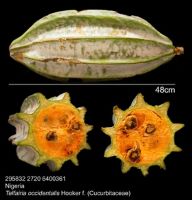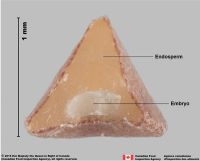Content is from Kirkbride et al. 2006Kirkbride et al. 2006:
Kirkbride JH, Jr, Gunn CR, and Dallwitz MJ. 2006. Family guide for fruits and seeds, vers. 1.0. Accessed September 2020-January 2022. URL: https://nt.ars-grin.gov/seedsfruits/keys/frsdfam/index.cfm ., without modification.
Updates are forthcoming.
Araucariaceae H. Henkel & W. Hochstetter
Common name: Araucaria Family.
Number of genera: 3 genera.
Number of species (Mabberley 1997): 39 species.
Cones: Dry; galbulus when dry (Spjut 3 families: Araucariaceae, Cupressaceae (now including Widdringtonia), Taxodiaceae); globoseglobose:
3D shape—more or less spherical , or elliptical (barely, in Wollemia); symmetrical; with scales; scales with fused subtending bracts. Fruiting scales present; dry; disintegrating; coriaceouscoriaceous:
, or elliptical (barely, in Wollemia); symmetrical; with scales; scales with fused subtending bracts. Fruiting scales present; dry; disintegrating; coriaceouscoriaceous:
texture—leathery
; shedding with seed(s) attached (Araucaria and Wollemia), or not shedding (Agathis).
Seeds: Arilaril:
(broad sense) appendicular structure that wholly or partly envelops a seed and is produced from or a modification of the funicle, raphe, or outer integument; usually fleshy or pulpy, sometimes spongy or tufted-capillate, often brightly colored absent. Seed larger than minute; 4–50 mm long; oblongoblong:
absent. Seed larger than minute; 4–50 mm long; oblongoblong:
2D shape—much longer than broad with nearly parallel sides, corners are rounded , or ovateovate:
, or ovateovate:
2D shape—egg-shaped in outline, widest point is towards one end of the organ, the other end tapers gradually, attachment at or near the broad end (compare obovate, ovoid) ; in transectiontransection:
; in transectiontransection:
a cross section; representing a plane made by cutting across an organ at a right angle to its length flattened; not bowl shaped; not nutlike; without winglike beakbeak:
flattened; not bowl shaped; not nutlike; without winglike beakbeak:
a usually firm, terminal appendage, sometimes tapered ; without caudatecaudate:
; without caudatecaudate:
tapering to a long, tail-like appendage appendage(s); at maturity with food reserves; with endospermendosperm:
appendage(s); at maturity with food reserves; with endospermendosperm:
nutritive starch- and oil-containing tissue present in many seeds ; without canavanine. Sarcotestasarcotesta:
; without canavanine. Sarcotestasarcotesta:
pulpy or fleshy outer layer of the seed coat, simulates aril absent. Testatesta:
absent. Testatesta:
seed coat
 present; without markedly different marginalmarginal:
present; without markedly different marginalmarginal:
at, on, or close to the margin or border
tissue; without pellicle layer; without fleshyfleshy:
texture—fairly firm and dense, juicy or at least moist, and easily cut
or leatheryleathery:
texture—moderately thick, tough, and very pliable
layer over hard layer; surface unsmooth; surface with merged raised features; surface longitudinally ribbedribbed:
surface relief—wide, prominent, linear ridges that are generally rounded and longitudinally situated on the surface , or wrinkledwrinkled:
, or wrinkledwrinkled:
surface relief—shallow, irregular folds and furrows covering the surface; appearing overall though crumpled and then spread out ; without crease or line separating cotyledons from hypocotyl-radicle; without notch along margin where cotyledons from hypocotyl-radicle tip approach each other; without glands; without bristles; glabrousglabrous:
; without crease or line separating cotyledons from hypocotyl-radicle; without notch along margin where cotyledons from hypocotyl-radicle tip approach each other; without glands; without bristles; glabrousglabrous:
without hairs
; Agathis with wing(s), or without wings (Araucaria); 2-winged; with wings on both sides; with wings unequally developed (one developed, one rudimentaryrudimentary:
(of embryo) embryo is small and fills less than a quarter of the seed and can be variable in shapes, such as linear, spatulate, or oval ); without collar; without operculumoperculum:
); without collar; without operculumoperculum:
a dehiscent cap (or lid) of a seed or fruit that opens during germination or dehiscence
 ; colored; monochrome; dark brown (all shades); firmfirm:
; colored; monochrome; dark brown (all shades); firmfirm:
texture—yielding under only moderately strong pressure; only slightly deformable without internal structural disruption
, or thickthick:
having or being of relatively great depth
; not becoming mucilaginousmucilaginous:
resembling mucilage; moist and sticky
when wetted; surrounding food reserve. Endospermendosperm:
nutritive starch- and oil-containing tissue present in many seeds copious; smooth; without fatty acid containing cyclopropene; without apicalapical:
copious; smooth; without fatty acid containing cyclopropene; without apicalapical:
at or pertaining to the end of the seed or fruit distal from its point of attachment (i.e., base)
lobes; without chlorophyll; without isodiametric faceted surface; without odor. Embryo differentiated from food reserve; well developed; 1 per seed; partially filling testatesta:
seed coat
 (with food reserve); 0.7–0.9 times the length of food reserve; at one end of seed not extending into a depression or cup; axileaxile:
(with food reserve); 0.7–0.9 times the length of food reserve; at one end of seed not extending into a depression or cup; axileaxile:
on or of the axis
and centric; linearlinear:
(shape) long, narrow, and uniform in width; (of embryo) embryo is straight and much longer than wide ; straight; parallel to seed length; embedded in endospermendosperm:
; straight; parallel to seed length; embedded in endospermendosperm:
nutritive starch- and oil-containing tissue present in many seeds ; with cotyledons gradually connected to hypocotyl-radicle; without coleorhiza; without simmondsin; without stomata; not green; with 2 or more cotyledons. Cotyledons 2 (or in some species appearing as 4 because cotyledons are deeply cleft); well developed; 0.5 times length of embryo; as wide as hypocotyl-radicle; 1 times wider than hypocotyl-radicle; partially concealing hypocotyl-radicle; not foliaceous; flat; smooth; with apicesapex:
; with cotyledons gradually connected to hypocotyl-radicle; without coleorhiza; without simmondsin; without stomata; not green; with 2 or more cotyledons. Cotyledons 2 (or in some species appearing as 4 because cotyledons are deeply cleft); well developed; 0.5 times length of embryo; as wide as hypocotyl-radicle; 1 times wider than hypocotyl-radicle; partially concealing hypocotyl-radicle; not foliaceous; flat; smooth; with apicesapex:
the point farthest from the point of attachment, or the "tip" of an organ entire, or cleft (deeply); with margins separate; basally entire; equal in size; not punctatepunctate:
entire, or cleft (deeply); with margins separate; basally entire; equal in size; not punctatepunctate:
surface relief—dotted with pits or with translucent, sunken glands or with colored dots, similar to pitted dotted. Hypocotyl-radicle well developed; straight; not thickened.
dotted. Hypocotyl-radicle well developed; straight; not thickened.
Literature specific to this family: Jones, W.G., K.D. Hill, & J.M. Allen. 1995. Wollemia nobilis, a new living Australian genus and species in the Araucariaceae. Telopea 6(2–3):173–176; Whitmore, T.C. 1980. A monograph of Agathis. Pl. Syst. Evol. 135:41–69.
General references: Engler, A. 1900–1953. Das Pflanzenreich, nos. 1–107. Facsimile edition. Engelmann-Cramer, Weinheim, Engler, A. & K. Prantl. 1924 and onward. Die Natürlichen Pflanzenfamilimien. W. Engelman, Leipzig, Gunn, C.R., J.H. Wiersema, C.A. Ritchie, & J.H. Kirkbride, Jr. 1992 & amendments. Families and genera of Spermatophytes recognized by the Agricultural Research Service. Techn. Bull. U.S.D.A. 1796:1–500, Page, C.N. 1990. Coniferophytina (Conifers and Ginkgoids). In: Kubitzki, K., ed., The families and genera of vascular plants, pp. 282–361. Springer-Verlag, Berlin, Mabberley, D.J. 1987. The plant-book, 706 p. Cambridge University Press, Cambridge, Morley, B.D. & H.R. Toelken, eds. 1983. Flowering Plants in Australia, 416 pp. Rigby, Adelaide, Schopmeyer, C.S. 1974. Seeds of Woodywoody:
texture—consisting mainly of indurate lignified tissues, characteristic of or resembling wood
plants in the United States. Agric. Handb. 450:1–883, and Spjut, R.W. 1994. A systematic treatment of fruit types. Mem. New York Bot. Gard. 70:1–182.